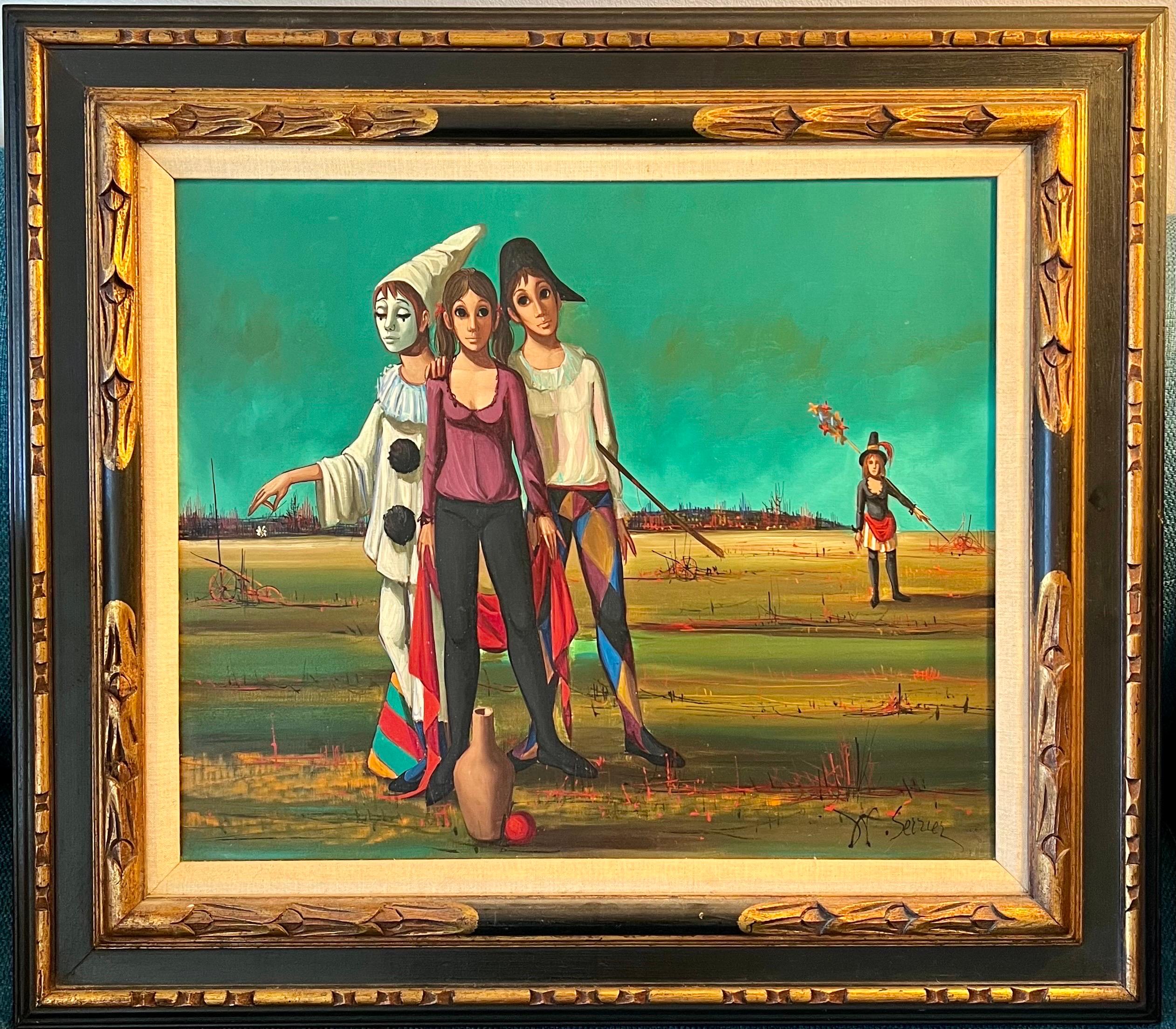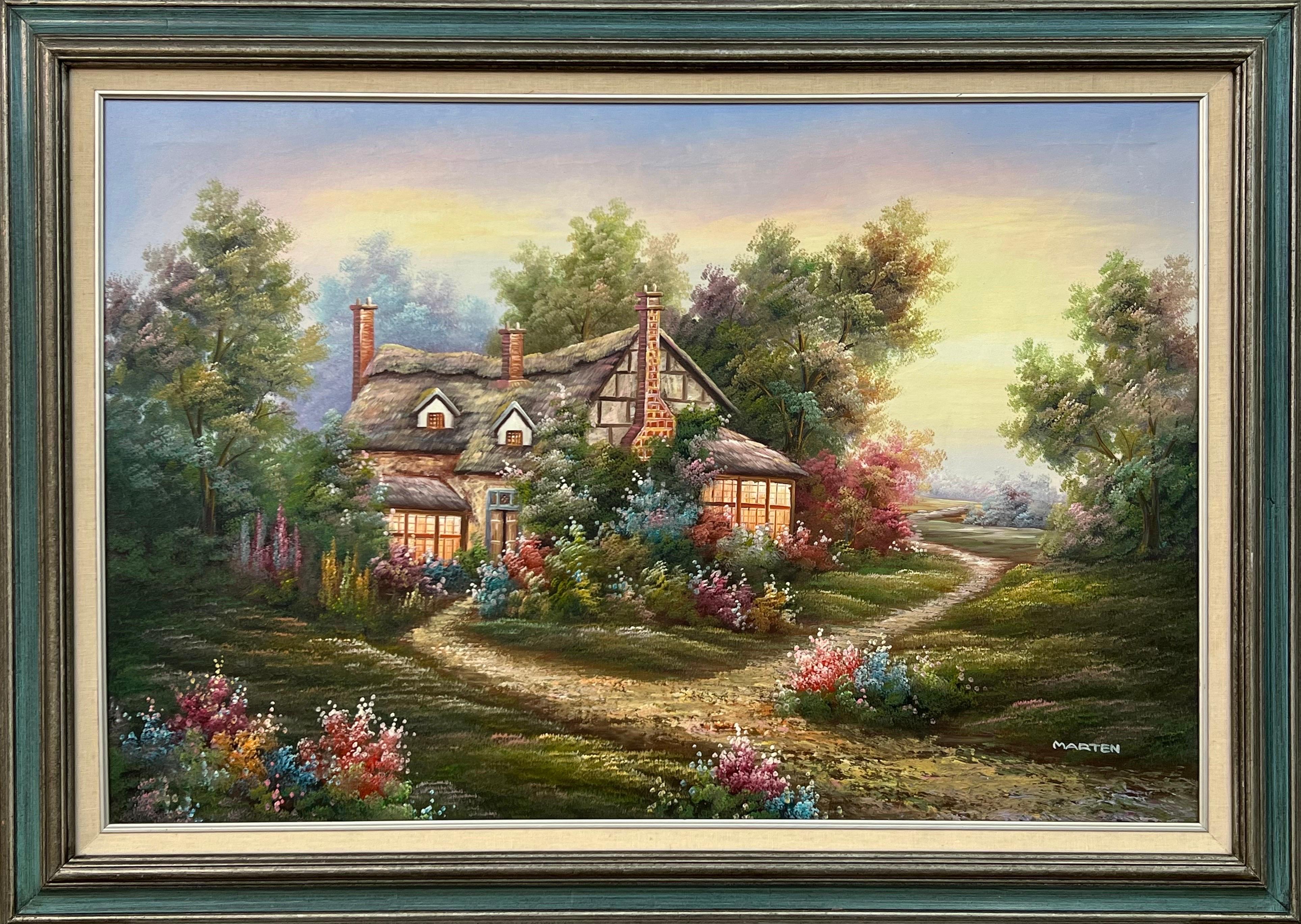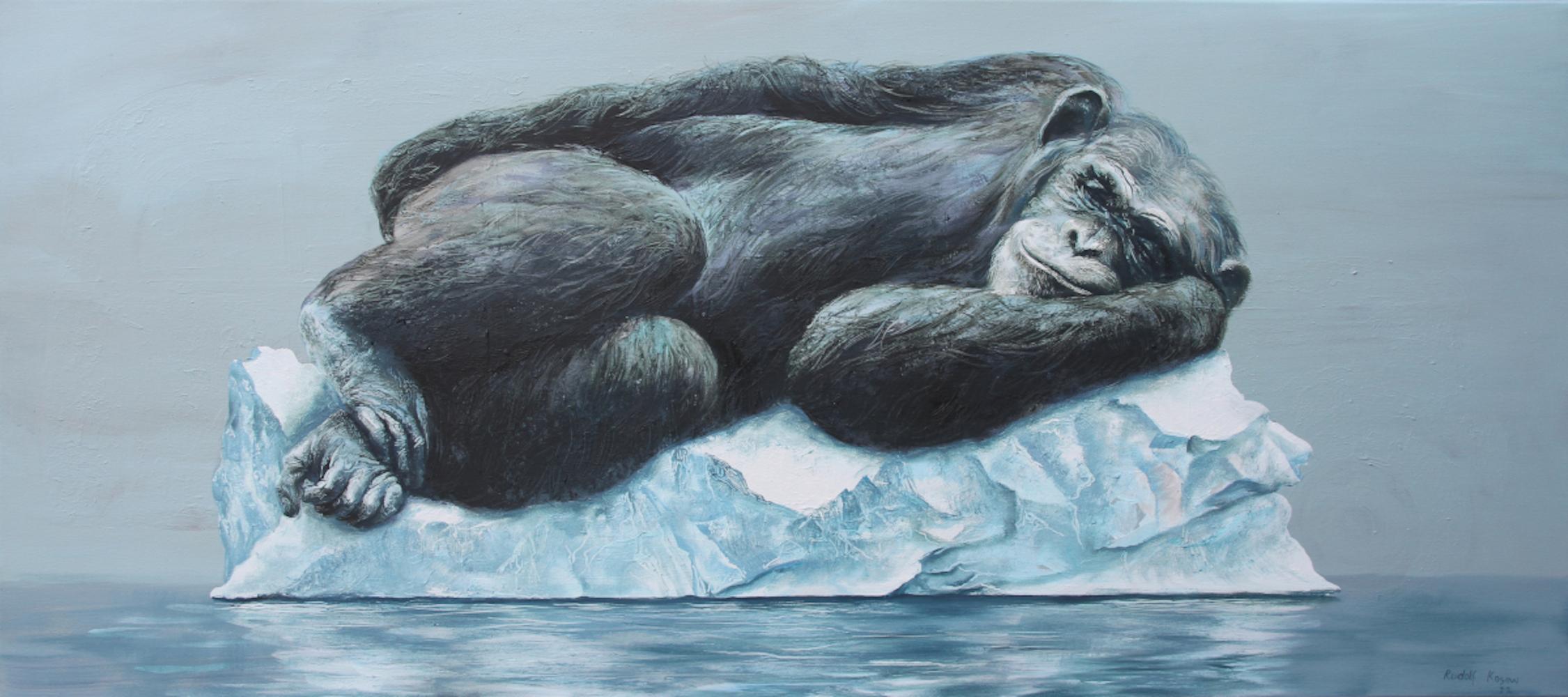Items Similar to Surrealist Very Large Late 20th Century Oil on Canvas. 'The Temple'.
Video Loading
Want more images or videos?
Request additional images or videos from the seller
1 of 22
Derek Carruthers Surrealist Very Large Late 20th Century Oil on Canvas. 'The Temple'.
About the Item
Very large Late 20th century surrealist oil on canvas by British artist Derek Carruthers. The painting is signed to the bottom right.
An imposing and highly colourful painting of colossal classical temples stacked in a totemic fashion encasing a naked heroic Graeco-Roman figure.
This painting is powerful and heroic in its representation. However, the temples are stacked shakily one on top of the other held together or constrained by scarlet red ropes. And within all this a human figure is encased or trapped, unable to barely move. The background of hills and trees is calm and inviting and although the sky is a deep blue with billowing white clouds a warning of ominous dark rainclouds appear to the right.
Carruthers often loved to use strong imagery to make a social comment. Do we enslave ourselves through dogma and organised religion? Does the individual in us become trapped and frozen by our self imposed rules and ideals? Are the ropes that bind the image here blood red to hint at the blood spilled over and over throughout history in the name of religion? Have we captured and enslaved God on earth to our ideals?
Carruthers likes to challenge our human perspective of what is normal. Using his constructivist approach to interlink art and architecture he takes images out of context or changes their relationship to each other either by manipulating size, juxtaposing images from different periods of time or by contrasting a beautiful background with its political or social meaning.
Derek Carruthers was an artist who persisted in asking questions. His whole career was inspired by the determination to enquire into the nature of art, examine its purpose, and attempt to explore that place where the individual life of the mind meets the external appearance of the world where personal sensation rubs up against cultural assumptions. Not surprisingly, Carruthers explored, over the years, a language of pure form, abstract space, 2 and 3 dimensions, narrative and concept, personal and universal figuration. Looking back, over decades of work, however, each of these voices is pursuing a coherent set of questions, reflecting on the stuff of human experience. Carruthuers’ individual pieces can intrigue and charm, they can be warm and poetic and they can also offer gritty resistance to the easy gaze. They can challenge us to think about ourselves, our environment, our expectations, our place in the world.
Carruthers grew up in the north-west of England having been born in Penrith, and one of his earliest memories of what art might be was formed by his encounter with the extraordinary creations of Kurt Schwitters. The latter had fled Germany in 1937, after his art had been labelled ‘degenerate’. He stayed, first, in Norway and then arrived in Britain in 1940. Carruthers had already encountered Schwitters' work as a boy, and had been launched on his own life-long examination of the nature of art.
Carruthers was further inspired by Victor Pasmore and Hamilton (British Constructivists) who were working closely together at King’s College London and eventually offered a challenging course to all first year students. Thus, Carruthers – who was at King’s in 1953 to 1957 was encouraged to take a rigorous approach to probing abstraction, spatial relationships, and the interlinking of art and architecture.
Having had the good fortune to have been an art student at such a time and in such a place, it is not surprising that Carruthers embarked on a voyage of artistic discovery. He showed his works with the major touring exhibition, organised by the Arts Council, in 1963, ‘Construction England’, together with Pasmore and Mary and Kenneth Martin.
His work was also included in exhibitions of new art at the Drian Galleries, Porchester Place, in 1963 to 1965. Reflecting the more recent re-examination of post-War, British Constructivism, Carruthers’ work was also included in the 1992 show, ‘British Abstract Art of the 50s and 60s’, held at the Belgrave Gallery. This early work, in which solid or relief forms change their nature as they – or the viewers – move through space and time, deliberately challenges the human tendency to find comfort in regarding the world as fixed and knowable.
In these years, too, Carruthers taught at Sunderland and Leicester Colleges of Art, before moving to lead the Fine Art course, as a Professor, at Trent Polytechnic (now the Nottingham Trent University). He was a dedicated educator, leaving to pursue his own art, full time, only in the mid 1980s.
Inspired, perhaps, by this freedom, the 1980s saw Carruthers exploring new ideas. He turned from working in 3-dimensions, or collage and relief, and rediscovered the power of traditional materials, oil and watercolour, on canvas and paper. He moved away from Non-Objectivity towards a practice which explored both abstracted and figurative imagery. Throughout, he remained preoccupied with exploring the human condition: by this trite remark, we mean that he continued to question how each individual experiences the world; he explored the ways in which human beings create totems to make their mark, as if to claim immortality; he tries to, ‘symbolise the triangular relationship between humankind and religion and the art / architecture which it inspires’. Hence - as well as warm glimpses of holidays and home life - his work yields the Egyptian pyramid, the Graeco-Roman heroic figure, the Christian monument; and, ultimately, the ‘sexless, ageless, raceless anonymity’ of the artist’s lay figure.
Derek Carruthers continued to ask questions, both about his life in a particular time and place, and about the lot of the human being on a universal scale. As an artist and a scholar, he saw himself at the intersection of these challenging states. And he makes you think........
- Creator:Derek Carruthers
- Dimensions:Height: 77.96 in (198 cm)Width: 53.94 in (137 cm)Depth: 0.79 in (2 cm)
- Medium:
- Movement & Style:
- Period:
- Condition:
- Gallery Location:Cotignac, FR
- Reference Number:
About the Seller
5.0
Platinum Seller
These expertly vetted sellers are 1stDibs' most experienced sellers and are rated highest by our customers.
Established in 2000
1stDibs seller since 2020
163 sales on 1stDibs
Typical response time: <1 hour
- ShippingRetrieving quote...Ships From: Cotignac, France
- Return PolicyA return for this item may be initiated within 3 days of delivery.
More From This SellerView All
- A Very Bad Seagull, Contemporary Oil and acrylic on CanvasLocated in Cotignac, FRSurrealist contemporary oil and acrylic on canvas by Scottish artist Frank McLean Docherty R.S.W, signed and dated bottom left and signed and titled 'A Ve...Category
2010s Surrealist Figurative Paintings
MaterialsCanvas, Oil, Acrylic
- Large Surrealist Oil on Canvas. 'She brought Colour into his Life'.By Frank DochertyLocated in Cotignac, FRLarge surrealist contemporary oil on canvas by Scottish artist Frank McLean Docherty R.S.W, signed and dated bottom left and signed and titled 'She brought Colour into his Life' to the reverse. This piece whilst wonderfully colourful, playful and erotic is typical of the witty sense of humour this artist displays in all his work. Docherty likes to tease us visually and asks questions and presents conundrums to the viewer. Frank McLean Docherty was born in Glasgow , Scotland in 1942. He became a student at Glasgow School of Art in 1960 and graduated from the Department of Printed Textiles in 1964. He taught in a secondary school in the East End of Glasgow for two years, thereafter departing to work in Dublin in the Republic of Ireland as a textile designer (Marks & Spencer, Heals and Liberty of London). He was also an illustrator for a range of newspapers and an Art Director of magazines. In 1973, he was appointed Principal Teacher of Art in a Scottish High School and in 1978 was honoured by the Queen when he was appointed Member of the Royal Society of Painters in Watercolours (R.S.W.) He left education in 1994. Since that time he has developed a vision which is quite unique in Scottish Art. Bank Managers, toucans, lighthouses, penguins, bowler hats, Frank Docherty...Category
21st Century and Contemporary Surrealist Landscape Paintings
MaterialsCanvas, Oil
- War and Peace, Mid-Century Surrealist Oil on Board.Located in Cotignac, FRMid-century Surrealist oil on board depicting War and Peace by Belgian Artist, Willy Smitz. Signed and dated bottom right with his recognisable triangular motif ( initialed WS ), in ...Category
Mid-20th Century Surrealist Landscape Paintings
MaterialsOil, Board
- Réalisme Fantastique, L'Etabli, The Work Bench, Mid Century Fantasy SurrealistLocated in Cotignac, FRFrench, réalisme fantastique, Surrealist oil on board by Claude Verlinde. Signed and dated bottom left. Presented in plain wood frame with gilt filet. ...Category
1950s Surrealist Figurative Paintings
MaterialsPanel, Oil
- Surrealist Gouache and Watercolour on Paper, The Three GracesLocated in Cotignac, FRLate 20th century surrealist gouache and watercolour on paper of The Three Graces by British artist Derek Carruthers. The painting is signed to the bottom right. An imposing and hig...Category
Late 20th Century Surrealist Figurative Paintings
MaterialsWatercolor, Paper, Gouache
- Surrealist Gouache on Paper, 'Threshold or Pagans'.Located in Cotignac, FRContemporary surrealist watercolour and gouache on paper by British artist Derek Carruthers. Signed bottom right. An intriguing and beautifully pain...Category
21st Century and Contemporary Surrealist Landscape Paintings
MaterialsPaper, Gouache
You May Also Like
- Holding Leather Bag (Brown leather bag surréaliste oil painting vintage dark)By Rudolf KosowLocated in Quebec, QuebecSuperbe bold original painting on canvas depicting the vivid portrait of a red boxing glove held by an anonymous figure in a coat. keywords; boxing glove, red glove, Brown coat, ame...Category
2010s Surrealist Figurative Paintings
MaterialsCanvas, Oil
- French Mod Surrealist Commedia dell'arte Circus Scene Oil Painting J.P. SerrierBy Jean Pierre SerrierLocated in Surfside, FLJean Pierre Serrier (French, 1934-1989) Oil on canvas painting depicting four figures Hand signed lower right. Measures (frame) 26.5" x 30" wide, and (sight) 18.25." x 22.25" wide. Jean Pierre Serrier (1934 – 1989) was a French painter known for surrealism and absurdist art. Jean-Pierre Serrier was born in Montparnasse, Paris and attended the Académie des Beaux-Arts in Paris. the son of Louis and Solange Serrier. His father fought in World War II and became a prisoner of war. In 1940, as a six-year-old, he and his mother fled Paris for Corrèze in southwest France. Childhood memories of close escapes from German bombardments would later influence his absurdist philosophy of life. Passionate about drawing, in 1951 he applied and was admitted to the École nationale supérieure des arts appliqués et des métiers d'art in Paris. He shared an attic apartment in the 16th arrondissement with fellow student Jean-Baptiste Valadié. For income, he decorated shop windows. A trip to Spain provided motifs for early works. His student work might be characterized as art naïf (Naive art). While still a student, he sold a ceramic artwork to the poet and publisher Pierre Seghers, who would later commission drawings from him. He frequented jazz clubs in Saint-Germain des Près, and while listening to Sidney Bechet at the Vieux Colombier, he met his wife, Yvette.One of the last French Surrealist and follower of Nietzsche. His art conveyed the message to all of mankind that we are only human. The other Surrealist to center his art in philosophy was Rene Magritte whose paintings reflect his understanding of Sigmund Freud. He had his first exhibition in 1955, before being sent to Algeria to complete his military service. After graduating in 1955, he was drafted for military service, spent time in Germany and Morocco, and was sent to the front lines of the Algerian War. In 1959 he exhibited works at two Parisian galleries and at Juan-les-Pins on the Côte d'Azur. From 1961, he exhibited annually at the Salon des Artistes Français. In 1962, the City of Paris purchased his painting Un dimanche In 1961, Serrier made his first visit to the United States to exhibit at a New York gallery. In 1975 and 1979, he had successful exhibitions in New Orleans, and his work was included in art and news magazines, including Time and Newsweek. Beginning in the 1950s, his works included stylized portraits similar in some ways to the "big eyes" art of Margaret Keane, though it is uncertain that either artist influenced the other. Keane painted children, and so did Serrier, sometimes from life, but Serrier’s models are usually somewhat older, though uniformly slender and with androgynous features. A gallery owner introduced Serrier to American collectors Edgar Garbisch and his wife, Bernice Chrysler (daughter of Chrysler founder Walter P. Chrysler), who had a particular interest in naïve art; they commissioned a series of portraits from Serrier. At the same time, he met Reine Ausset in Paris, who in 1961 invited him to New York to take part in an exhibition at Galerie Norval on 57th Street. The show also included work by Moïse Kisling, and the exhibition program explicitly linked the two artists, saying that Serrier, who considered Moise Kisling "the Master," had found his own technique, but "the same vision joins the grand Kisling to the young Serrier: plenitude of shapes, sureness of palette, precision in outlines." In the 1960s he began painting slender, young, androgynous figures in groups, set in sparse landscapes with suggestions of the surreal and sometimes wearing costumes of the Commedia dell'arte. In some of these paintings the eyes of the figures are completely black, a motif that would continue in his later work. In 1965, he exhibited at Forest and Reed Gallery in London. Also in 1965, he discovered the small town of Martel, and with his old roommate Jean-Baptiste Valadié purchased a house that they opened as the gallery La Licorne (The Unicorn) in 1967. Responding to the political upheavals of May 1968 in France, and following the advice of Geneva gallery owner Roger Ferrero, Serrier's work became increasingly complex, idiosyncratic, and surreal. Imagery included the Tower of Babel, bodies suspended in space, and crowds of people all dressed alike, with identical features and entirely black eyes. Mannequins, playing cards, nudes, and levitating orbs also figured in the work. In a nod to Magritte, his men sometimes wear bowler hats. Another influence may have been the works of the Franco-Belgian surrealist Gaston Bogaert (1918-2008). Serrier's first major exhibit of these works, in Geneva in 1971, was titled Le Réalisme Fantastique. (Magic Realism) In 1972, he was made a member of the Société du Salon d'Automne, under whose auspices he was invited by the Polish government to exhibit in Warsaw in 1973, as part of a cultural exchange across the Iron Curtain. In 1976, he served on the jury of the Salon d'Automne. In 1975, New Orleans gallery owner Kurt E. Schon brought his work to several cities in the United States. A copiously illustrated monograph in English, Surrealism and the Absurd: Jean Pierre Serrier, was published in 1977. Author Thomas M. Bayer wrote: Serrier's world is one where—to use Friedrich Nietzche's term—the "human herd animal" is being confronted with the overwhelming task of coping with the world, his solitude, and at times, his resignation in the face of its monstrous size and duration. It is a world where the characterless, "blind" man faces the institutions, rules and symbols that made him into the being he now is…But Serrier does not lose himself in this world he portrays. He never forgets the old French tradition, the "black" humor, à la Molière. This classical humor at times is more felt than seen, in a manner that can be terribly funny, because it is horrifying, laughable, poignant and always true. Serrier told a friend, "In each of my paintings there's a message of hope amid the crowd of stereotypical figures. It could be an escaping dirigible, or a nymphet who flees like a deer under the red and blue trees of paradise...Category
Mid-20th Century Surrealist Figurative Paintings
MaterialsOil, Canvas
- Vintage Oil Painting of Fantasy Cottage in the Woods with Flowers & GardensLocated in Preston, GBVintage Oil Painting of Fantasy Cottage in the Woods with Flowers & Gardens Art measures 36 x 24 inches Frame measures 40 x 28 inchesCategory
1980s Surrealist Landscape Paintings
MaterialsCanvas, Oil
- Dreamers (yellow banana vintage car surrealist oil painting grey monochrome)By Rudolf KosowLocated in Quebec, QuebecTwo photographic motifs, which can by no means fit together in real life, result in a coherent and at the same time completely absurd image on a painting level. It may symbolize wishful thinking which can never be realized in reality. keywords; americana, surrealism, yellow banana, vintage, oil painting, men figurative painting...Category
2010s Surrealist Figurative Paintings
MaterialsCanvas, Oil
- Mind Blowing (vintage car surrealist oil painting grey monochrome dessert cake)By Rudolf KosowLocated in Quebec, QuebecTwo photographic motifs, which can by no means fit together in real life, result in a coherent and at the same time completely absurd image on the painting level. Something that has happened, you can see things clearly in front of you and still do not understand how often in real life what it all means. keywords; americana, surrealism, rasberry cake, vintage, oil painting, men figurative painting...Category
2010s Surrealist Figurative Paintings
MaterialsCanvas, Oil
- Leaf and couple (yellow oil painting vintage black and white Picture couple)By Rudolf KosowLocated in Quebec, QuebecLEAF AND COUPLE is a superbe and vivid original painting on canvas depicting a still life of a fall leaf next to a vintage black and white photograph of a couple in a tender brace. ...Category
2010s Surrealist Figurative Paintings
MaterialsCanvas, Oil


